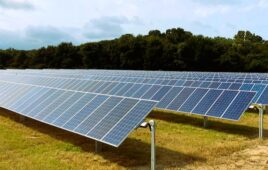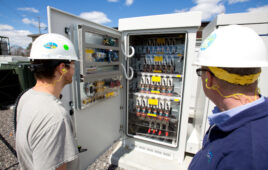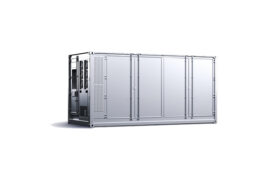Microgrid company CleanSpark announced it has achieved government acceptance of its solar-plus-storage microgrid located at the Marine Corps Base Camp Pendleton in California.
Camp Pendleton is the major West Coast base of the United States Marine Corps and is one of the largest Marine Corps bases in the United States. Completed by general contractor Bethel-Webcor JV, the Communications Information Systems (C.I.S.) Operations Complex includes a data center, headquarters facility, maintenance and supply warehouse, and related communications infrastructure. The complete project receives backup power from UPS and traditional standby generators provided by other contractors. A subset of the critical loads are served by CleanSpark’s advanced solar-plus-storage microgrid using a 400-kWh iron-flow battery from ESS DC-coupled with 150-kW solar PV generation located on both carport shade structures and the buildings’ roofs. CleanSpark was responsible for the optimization, design, engineering, and deployment of the microgrid.
“There have been quite a few technology achievements on this project, but what excites me the most is the functional outcome,” said Anthony Vastola, SVP of projects for CleanSpark. “This is a hybrid zero-net-energy facility incorporating both off-grid and grid connected renewable generation that work together to support project economics while also providing energy security. With strong system modelling, innovative engineering expertise, and effective microgrid control, we believe economics and energy security should go together.”
The first project to receive CleanSpark’s latest mPulse DER Energy Manager, operational intelligence is co-located with the microgrid offering resilient communications disconnected operation and increased cyber-security leveraging its hybrid-cloud configuration. The on-site generation solution includes separating the building loads so that the priority loads are on the islanded system and non-priority loads are served from the utility with each renewable asset interacting with the grid based on mode of operation.
“We are pleased to commission our second Energy Warehouse system in a military microgrid application,” said Craig Evans, Founder and CEO of ESS Inc. “Camp Pendleton is the Marine Corps’ largest West Coast expeditionary training facility for Marine, Army and Navy units. The Camp will especially benefit from our battery’s solar-plus-storage capabilities, which enable the microgrid to store excess solar energy for later use during times of peak electricity demand.”
News item from CleanSpark





Its nice to see something other than vanadium flow batteries being installed for proof of concept energy storage facilities. I believe it is the ESS system that uses two different ions of iron to generate power in their cell stacks. Iron is cheaper to come by and using the same ions with different charges makes the system less likely to hard fail, although the membranes in the cell stacks could crack and allow ions to flow through without creating a power flow. Degradation can be monitored and managed, failure is panic time. Cell membrane conditions can be ‘calculated’ by using CTs on the cell output leads and knowing the flow rate into the cell. If the current drops off precipitously out of the cell per ion flow into the cell with respect to other cells in the stack, then the membrane needs attention, perhaps a cell swap out for a new cell. Cell current drop off with respect to cell input flows can also be used to create a state of charge meter, much like a gas gauge.